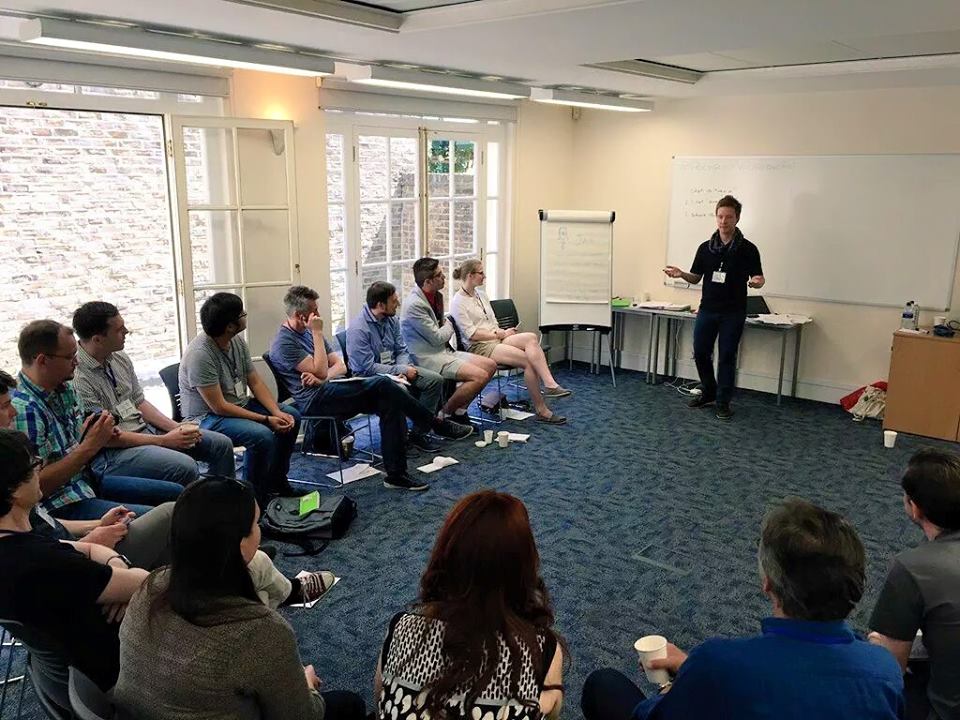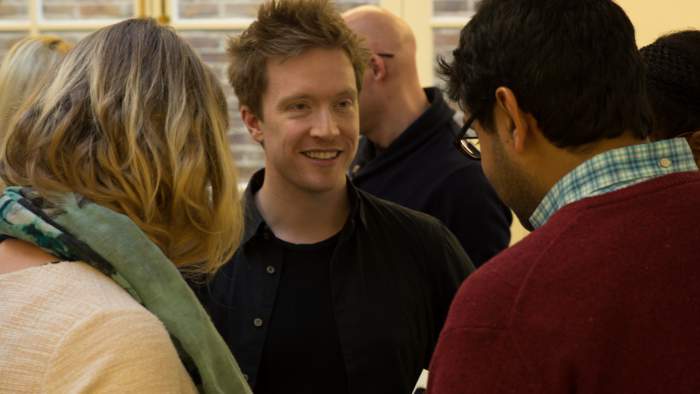Why You’re Stuck At Intermediate Spanish … And How To Break Through The Plateau
Is your progress in Spanish slowly grinding to a halt?
Did you breeze through your beginner lessons, only to run into a brick wall as you approach intermediate Spanish?
If so, grab a pen and paper, and clear your schedule for the next 5 minutes…
I’m going to show you the following:
- Why your progress in Spanish seems to be slowing
- The “intermediate plateau” – and why it’s important
- The problem with your current study method
- 10 ways to use the “whole language” to get unstuck and bring fluency in Spanish one step closer
Getting stuck at intermediate level in a language is a well-documented phenomenon, and you’re not alone!
I’ve squared up to this predictable roadblock in all the 8 languages I speak, and come out on top most of the time!
Once you understand what’s going on, and commit to studying in a new, exciting way, you can shake off the cobwebs and breathe a new lease of life into your Spanish overnight.
The Honeymoon Period of Beginner’s Spanish
I began learning Spanish by myself, many years ago, in a grey, asphalt corner of London, England.
During the first few months, I felt like I was learning quickly.
I had some native speaker friends around me, and they taught me a lot of cool phrases, such as colloquial ways of greeting people: ¿Cómo estamos? ¿Qúe pasó, tío?
And some cool replies: ¡No tan bien como tú!
My first conversations didn’t amount to much, but I was so excited to be really communicating in Spanish!
(What I didn’t know at the time is that when you’re a beginner people have a tendency to humour you, and make you feel like you’re a much better speaker than you actually are!)
I gained vocabulary.
I learnt some basic verb conjugations.
Before long, I could start making up my own sentences, not just repeating the same things I learnt in my books.
Every day, after practicing with my fiends, I would go home feeling great, and thinking: “I'll be fluent in Spanish in no time!”
I remember even starting to flip ahead in my textbook, excited about the next lesson.
The Roadblock Hit Me Like A Ton Of Bricks
Sure enough, the honeymoon period came to an end.
It happened to me in Spanish, and it’s happened in every language ever since…
At first, it's easy and fun.
Then something changes. You're not sure why. You may not know exactly when. You can't quite put your finger on what happened. Yet, at some point, you stop feeling like you're really learning.
Things start to become frustrating.
Maybe it's a grammar point that you just can’t get right: choosing between the infamous ser and estar, for example. Or conjugating your –ir and –er verbs in different tenses.
No matter how long you go over the rules, you still make mistakes.
No matter how many times you conjugate verbs on paper, it still takes you ten minutes to utter a decent sentence.
You wonder if you're not meant for language learning. Maybe you blame your teacher. Maybe you start looking into French classes, convinced that Spanish just isn't your cup of tea.
Well, I can’t vouch for your teacher, but I can tell you this…
Hitting this language roadblock is totally normal. In fact, it even has a name. It's called the “intermediate plateau”.
The Intermediate Plateau in Language Learning (and Why It Matters)
When you start learning a new language, your progress has a positive gradient.
Your knowledge builds quickly, and that makes the process fun! Every word you learn seems immediately useful…
- Verbs like: comer, beber, entender or gustar
- Nouns like: bebida, teléfono, casa
- Adjectives like: rápido, inteligente, bueno
Eventually, your learning levels out to a plateau.
By this stage, you already know the most common words in Spanish. Your speaking may lack finesse, but you can hold a conversation in Spanish, and get your point across.
From this point on, everything you’re learning now seems less and less useful in conversation:
- Verbs like: mascullar (to mumble) , engrapar (to staple), or apoderar (to empower)
- Nouns like: herramientas (tools), estantería (bookshelf), huerta (orchard)
- Adjectives like: tibio (warm), hervido (boiled), and so on…
Not only do you not need this vocabulary right away, you might go for weeks or months without using these words even once.
Because your new vocabulary is harder to use, you have the impression that you’re not progressing as quickly as before.
But this is just an illusion.
In fact, you’re still learning just as much as before – it just doesn’t feel that way!
Finer Shades Of Meaning Are Harder To Get Right
This feeling of diminishing returns isn’t limited to vocabulary.
It also extends to Spanish grammar.
When you start learning Spanish, you begin with the present tense. Next, you learn the preterit to discuss things in the past, and perhaps one of the future constructions to talk about future plans.
These tenses are great for explaining immediate needs and telling simple stories.
When your Spanish reaches intermediate level, though, you begin to encounter other forms of grammar that are used to convey finer shades of meaning, such as other forms of the past tense, the conditional and the subjunctive

“Why do we need all these tenses?” you might catch yourself thinking!
Consider the different ways you might ask a colleague to go to the bank – using the subjunctive:
- Quiero que vayas al banco
- Me gustaría que fueras al banco
- Me gustaría que fueses al banco
Now, you might spend months studying how to use the subjunctive accurately, but it doesn’t make a great deal of difference to your ability to communicate – you can get your point across with a rudimentary: Vas al banco, por favor (and a smile).
Once again, it feels like a lot of study, for not much return.
A Strategy For Breaking Through The Intermediate Plateau In Spanish
Essentially, what we’ve been talking about up until now is a growing disconnect between what you’re studying, and what you need in order to communicate.
The more your learn, the more abstract it becomes.
The key to progressing past the intermediate plateau in Spanish is to make everything you're learning feel relevant and useful.
Only once your learning appears relevant and useful will your brain work hard to retain it.
In order to make more advanced Spanish feel useful, you need to go beyond the textbook and study the whole language.
“Whole language” is the opposite of grammar exercises and word lists in your textbook. It means spending time with Spanish in context – as it is used in real life.
You study the whole language when you do two things:
- Connect with Spanish regularly through self-study and personal interest
- Make Spanish part of your daily life (not just an activity for study time or weekends)
The best way to learn Spanish on your own involves speaking with others and interacting with the language beyond the classroom, especially by doing things that you enjoy.
When you learn Spanish this way, new words and phrases automatically have meaning from the context you find them in – even if they’re less frequent.
Not only that, but learning with the “whole language” massively increase your exposure to the Spanish language, resulting in exponential opportunities to learn.
(Oh, and doing things this way is also a lot more fun!)
Let’s talk about practical ways to do this:
10 Ways To Beat The Intermediate Plateau
1. Read. Listen and read. Listen
Becoming fluent in Spanish requires you to spend a lot of time in the company of the language. The easiest way to do this is by listening and reading to things you enjoy. However, material intended for native speakers can be difficult to understand. The most effective way to learn with real Spanish is to find listening material that comes with the transcript (Or books that come with the audio).
When you can read what you hear (or vice versa), you have far more chance of learning and retaining the information. Your listening skills also improve, as you can find clues in the text that you might not be able to hear by yourself.
Here's how to do it:
- Find audio (podcasts, music, or audio recordings of books) that also has a written transcript
- Listen multiple times without stopping the recording
- Focus on pushing your ear to pick up as much it can by itself
- Then, add the transcript and look up any difficult vocabulary
- Continue to listen and read, trying to increase your understanding each time
- When you’re confident of understanding the text, hide the transcript and see if you can understand everything just by listening
Here's an example of this approach in practice:
It’s important not to use material that’s too far above your level. If you're not sure where to get good material for this, check out the Fluent Spanish Academy.
2. Listen to music or podcasts during your commute
Do you commute to work or school? If so, then try listening to music or podcasts in Spanish in the car or on public transportation. Podcasts usually employ clear, well-articulated speech, making it easy for learners to listen. You can even find podcasts specifically for learners.
Listening to music without the help of transcripts is a less effective study method than the “Listen. Read. Listen and read. Listen.” method described above. However, it may be easier to fit into your daily routine and you might decide to look up lyrics for favourite songs later, after hearing them a couple of times.
3. Read a novel in Spanish
If you’ve never tackled a book in Spanish before, start with a translated book that you've already read in English. That way, you'll already know the plot and will have a “scaffold” to help you handle new vocabulary, thereby spending less time with a dictionary.
When you're ready for a real challenge, grab a novel originally written in Spanish. If you don't know any authors, look for something by Isabel Allende. She's a Chilean author with tons of classic titles that can easily be found both online and in bookstores. I also like Gabriel García Márquez, the late Colombian novelist.
4. Create Regular Opportunities To Speak Spanish

Readers of Fluent in 3 Months hardly need reminding of the need to speak their target language. However, one thing is knowing it, another is doing it. It’s easy to fall into the habit of studying Spanish and never getting into the habit of speaking it – because speaking Spanish regularly requires you to get off the sofa and haul yourself out to language events…or at least to your computer!
Speaking is so fundamental to breaking through the intermediate plateau that you must make sure you’re speaking at least 2-3 times a week before you worry about anything else. Doing this will throw all kinds of unexpected situations at you, and give you the option to put into practice everything you’re learning. There are tonnes of ways to meet native speakers, but with iTalki.com (online) and Meetup.com (real world) you’re covered.
5. Do online searches in Spanish
How many times a day do you search for information online? Is there anything stopping you doing your searches in Spanish? No. Product reviews, recipes, destination guides… they’re all great ways to get meaningful Spanish practice, and learn a lot of incidental language while you’re at it.
6. Use your phone in Spanish
Go into your settings and set your phone's language to Spanish. About 90% of the time you probably navigate your phone using mostly icons anyways, so you won't get too lost or frustrated. However, you will give yourself constant, daily interactions with Spanish.
7. Watch TV shows in Spanish
If you like watching TV, switch out your English shows for Spanish language ones, like El Príncipe. Don’t go anywhere near the English subtitles – put on the Spanish ones instead!
If you usually watch with English-speaking friends, bilingual shows like Narcos can stimulate your Spanish without leaving your friends in the dust.
8. Get your news in Spanish
Reading the news is a daily activity for most of us. Getting your news in Spanish is a great way to add purposeful language time into your day, related to your own interests. BBC Mundo has a widget that you can download for the home screen of your Android phone. You can also check out paper and online versions of newspapers from whatever country or city most interests you.
9. Read blogs, comics & other online material in Spanish
Often, one of the best ways to find stimulating material in a foreign language is to simply ask yourself the question: “What do I do for fun in my own language?” Run through a list of things you typically look up online, and you ought to be able to find something similar in Spanish.
10. Take general-interest classes run in Spanish
If you live in an urban area, you may be able to find classes run in Spanish. I searched “españoles en londres” and found this site which is a wealth of opportunities for meeting Spanish speaking people in my hometown. Even if you take classes in English that have a Spanish connection, such as Salsa classes, you’re putting yourself in a great position to meet native speakers at some point down the line.
Conclusion: The Secret To Fluent Spanish
What I want you to notice from all these ideas is this:
You can’t keep studying the way you used to.
Simple lessons and grammar exercises may have helped you get started in Spanish, but it doesn’t cut it beyond the beginner stage.
Breaking through the intermediate plateau in Spanish means immersing yourself in the “whole language” with activities that you are personally invested in.
By making Spanish part of your lifestyle, and not waiting until the day when you feel “ready”, you will not only improve faster, but have a lot more fun!



Social